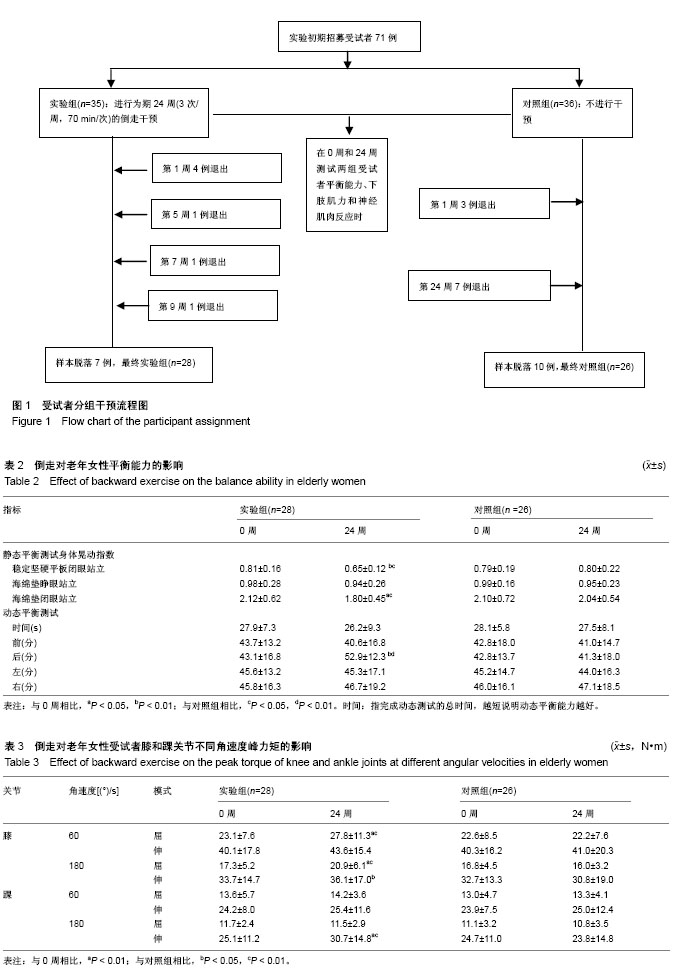| [1] 彭希哲,卢敏. 老年人口死亡概率时代变迁与老年定义的重新思考[J]. 人口与经济, 2017(2):1-10.[2] 常书婉,周继和,洪友廉,等. 长期太极拳练习对老年女性平衡能力的影响[J]. 成都体育学院学报,2014,40(4):42-47.[3] 邹魁,程亮. 弹力带柔性抗阻训练对老年女性关节肌力和平衡能力的影响[J].中国老年学杂志, 2017,37(18):4611-4612.[4] Cheng L, Chang S, Li J, et al. Effects of different periods of Tai Chi exercise on the kinesthesia of the lower limb joints of elderly women. Res Sports Med. 2017;25(4):462-469.[5] Chang S, Zhou J, Hong Y, et al. Effects of 24-week Tai Chi exercise on the knee and ankle proprioception of older women. Res Sports Med. 2016;24(1):84-93.[6] 林长地,程亮,林晞. 全身振动训练对老年女性平衡能力和下肢关节肌力的影响[J]. 首都体育学院学报,2015,27(6):572-576.[7] Arnold P, Vantieghem S, Gorus E, et al. Age-related differences in muscle recruitment and reaction-time performance. Exp Gerontol. 2015;70:125-130.[8] Ballanger B, Boulinguez P. EMG as a key tool to assess motor lateralization and hand reaction time asymmetries. J Neurosci Methods. 2009;179(1):85-89. [9] Abdel-Aziem AA, El-Basatiny HM. Effectiveness of backward walking training on walking ability in children with hemiparetic cerebral palsy: a randomized controlled trial. Clin Rehabil. 2017;31(6):790-797. [10] Kim CY, Lee JS, Kim HD. Comparison of the Effect of Lateral and Backward Walking Training on Walking Function in Patients with Poststroke Hemiplegia: A Pilot Randomized Controlled Trial. Am J Phys Med Rehabil. 2017;96(2):61-67. [11] 韩东波,徐冬青. 倒走运动的生物力学特性的研究进展[J]. 中国康复医学杂志, 2011,26(10):990-993.[12] 巴洪冰. 倒走对老年女性下肢选择反应时和平衡能力的影响[J]. 中国老年学杂志, 2017,37(14):3356-3357.[13] 张建. 16周倒走对老年女性静态平衡能力的影响[J]. 中国老年学杂志, 2016,36(8):1970-1971.[14] Kim SH, Yoon YB. Effect of Backward Walking on Isokinetic Muscular Function, Low Back Pain Index and Lumbosacral Angle in Unilateral Exercise Athletes. Indian J Sci Technol. 2016;9(25):1-6.[15] 杨蕾,程亮. 8w振动训练对老年女性下肢关节肌力和耐力的影响[J]. 中国老年学杂志,2015,35(5):1250-1252.[16] 卢澎涛. 不同频率全身振动训练对老年女性骨密度及下肢肌力的影响[J]. 山东体育学院学报, 2016,32(6):89-94.[17] 李旭龙,纪仲秋. 太极拳和健美操锻炼对大学生静态平衡能力的影响[J]. 中国运动医学杂志, 2013,32(7):591-595,600.[18] 赵龙飞,张油福,国伟,等. 在校大学生动静态平衡能力的相关性及影响因素[J]. 体育科研,2017,38(2):74-77.[19] 刘建国,汪美群,郭素英,等. 静态姿势图在良性阵发性位置性眩晕中感觉结构变化研究[J]. 中华耳科学杂志, 2016,14(4): 464-468.[20] 王璟,周玉娟,余菁,等. 优势偏向在外周性眩晕患者前庭功能评估中的意义[J]. 中华耳鼻咽喉头颈外科杂志, 2017,52(3): 200-204.[21] 计莉,孙勍,彭新,等. 良性阵发性位置性眩晕患者的静态平衡功能特点研究[J]. 中国听力语言康复科学杂志, 2016,14(3): 207-211.[22] 曹春婷,李琪,刘媛媛,等. 头-眼运动训练视频在前庭康复中的应用[J]. 中国耳鼻咽喉头颈外科, 2017,24(5):245-247.[23] 李广周,何本祥,刘建宇,等. 长期有规律锻炼对女大学生静态平衡能力的影响[J]. 重庆三峡学院学报, 2016,32(3):107-111.[24] 郝凤霞,刘铮,刘丽志,等. 悬吊训练干预对少年聋哑症患者平衡能力的影响[J]. 河北师范大学学报(自然科学版), 2016(1): 88-92.[25] 张彪,刘鸿宇,武俊英,等. 感觉整合模式对偏瘫患者维持平衡的作用[J]. 中国康复医学杂志, 2016,31(9):973-978.[26] 吴雪萍,闻一鸣,孟杰. 坐位振动训练对下肢运动功能障碍者平衡功能的影响[J]. 河南师范大学学报(自然版), 2017(4): 118-124.[27] Campbell AJ, Robertson MC, Gardner MM, et al. Randomised controlled trial of a general practice programme of home based exercise to prevent falls in elderly women. BMJ. 1997; 315(7115):1065-1069.[28] Shigematsu R, Okura T. A novel exercise for improving lower-extremity functional fitness in the elderly. Aging Clin Exp Res. 2006;18(3):242-248.[29] 姚鑫. 健身反向走对老年女性平衡能力的影响[J]. 山东体育学院学报, 2008,24(10):59-61.[30] Laufer Y. Effect of age on characteristics of forward and backward gait at preferred and accelerated walking speed. J Gerontol A Biol Sci Med Sci. 2005;60(5):627-632. |
.jpg) 文题释义:
身体晃动指数:当受试者站立于测试平台上,身体压力中心在各方向上有一定的移动,设备通过计算左右前后方向移动轨迹和位移来确定受试者的身体晃动指数,越小说明平衡稳定性越好。
峰力矩:等速肌力测试指标之一,能衡量测试关节在测试角度内最大力矩值,能反映受试者该关节在相应角速度测试下的肌力水平。
文题释义:
身体晃动指数:当受试者站立于测试平台上,身体压力中心在各方向上有一定的移动,设备通过计算左右前后方向移动轨迹和位移来确定受试者的身体晃动指数,越小说明平衡稳定性越好。
峰力矩:等速肌力测试指标之一,能衡量测试关节在测试角度内最大力矩值,能反映受试者该关节在相应角速度测试下的肌力水平。.jpg) 文题释义:
身体晃动指数:当受试者站立于测试平台上,身体压力中心在各方向上有一定的移动,设备通过计算左右前后方向移动轨迹和位移来确定受试者的身体晃动指数,越小说明平衡稳定性越好。
峰力矩:等速肌力测试指标之一,能衡量测试关节在测试角度内最大力矩值,能反映受试者该关节在相应角速度测试下的肌力水平。
文题释义:
身体晃动指数:当受试者站立于测试平台上,身体压力中心在各方向上有一定的移动,设备通过计算左右前后方向移动轨迹和位移来确定受试者的身体晃动指数,越小说明平衡稳定性越好。
峰力矩:等速肌力测试指标之一,能衡量测试关节在测试角度内最大力矩值,能反映受试者该关节在相应角速度测试下的肌力水平。


.jpg) 文题释义:
身体晃动指数:当受试者站立于测试平台上,身体压力中心在各方向上有一定的移动,设备通过计算左右前后方向移动轨迹和位移来确定受试者的身体晃动指数,越小说明平衡稳定性越好。
峰力矩:等速肌力测试指标之一,能衡量测试关节在测试角度内最大力矩值,能反映受试者该关节在相应角速度测试下的肌力水平。
文题释义:
身体晃动指数:当受试者站立于测试平台上,身体压力中心在各方向上有一定的移动,设备通过计算左右前后方向移动轨迹和位移来确定受试者的身体晃动指数,越小说明平衡稳定性越好。
峰力矩:等速肌力测试指标之一,能衡量测试关节在测试角度内最大力矩值,能反映受试者该关节在相应角速度测试下的肌力水平。